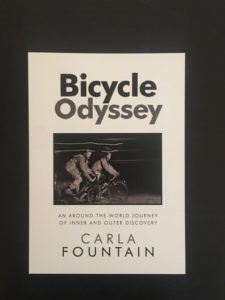
Bicycle Odyssey, a travel memoir by Carla Fountain
November 1991 was the sixth month of our around-the-world bicycling trip. We arrived at the international airport in Bombay (Mumbai), tired and on edge after an all-night flight with little sleep. As we circled in for a landing in the early-morning light, Bombay spread out for miles and miles before us, full of high-rises, large buildings, and highways. Moments before we hit the runway, the view filled with shanty towns. The makeshift huts, crafted out of planks of wood covered with tin roofs, jammed together amid heaps of trash.
We wheeled our bikes out of the baggage claim area. Earlier, we had considered staying in Bombay for a few days, but the sight of the immense city daunted us. We thought it better to stick to our original plan and travel to the state of Goa as quickly as possible. Once there, we would start our cycling trip of the subcontinent. We wanted to skip the huge city of Bombay and begin our bicycle journey in a more manageable area. We found out we had to change terminals for our domestic flight. We pumped up our tires, snapped on our lightened load of one pannier each, and cycled out onto the streets in search of Bombay’s domestic terminal.
When we had started out, we didn’t know India was known for having some of the world’s deadliest roads. But shortly into our trip of bicycling the subcontinent, we would have concurred. Trucks, motorbikes, and cars zoomed around us, honking nonstop. We passed paving work and construction sites. Women squatted next to piles of rocks, breaking them into smaller chunks. Their bright-colored saris in pinks, yellows, and greens contrasted sharply with their arduous labor.
We asked three different people for directions to the domestic airport and received three different answers.
“It is ten miles away. Go straight,” an older man answered.
“You must go five miles. Then turn left,” another man said.
“It’s twenty minutes from here. First go straight, then left,” a third man told us.
We biked straight, turned left, and joined honking buses, three-wheeled taxis, and mobs of pedestrians on the road.
A helpful man gave us new directions. “Go there and then that way.”
We bumped into more road construction, which blocked off our lane. Joining other local cyclists, we braved the oncoming traffic. But after several three-wheeled taxis swerved toward me and forced me off the road, we decided to walk the road construction out.
We followed new instructions: “Shortcut. Very good. Ten minutes away.”
Those directions led us into a slum with narrow streets. The smell of excrement filled the air. We had to be careful not to run over piles of human waste on the side of the road. Amid all the squalor and dirt, a woman fluttered by in a pink and mauve sari. She was a butterfly floating over a dung heap. Her beauty transcended the filth and chaos.
Farther on, three children squatted, bare bottomed, with their backs to the road, adding piles to the trash. Afterward, they helped each other clean up with water. A fat, muddy pig with swollen teats rooted in the garbage. Men scrubbed down oxen. Another woman in a dazzling, green sari walked by.
We could see that the road construction progressed slowly. Men broke up the old road with pickaxes or power tools, while women scooped up the broken asphalt in trays, which they carried on their heads over to a pile away from the road. The tedious, hard work kept many people occupied and employed.
When we reached the domestic airport, it felt like we had cycled in a huge circle. Six hours after landing in Bombay, we boarded our flight to Goa. We arrived after nightfall. Because we couldn’t bike to the city of Vasco da Gama in the inky darkness, we took a taxi and replenished with meals at two different restaurants. We ate chicken kebabs in the first and vegetables and rice in the second. We strolled through the bazaar and ordered a nightcap of whiskey and soda in a cozy bar. The sweet scents of incense and flowers filled the night air on our way back to the hotel.
I paused to admire the lights and color of the bazaar. “This is wonderful, Derm! I’m so glad we decided to fly to Goa to start our trip in India.”
“No one told us that we would have to bicycle ten miles to change terminals. That was a crazy ride. It feels good to relax now in the calm.” Dermot sighed.
Music played from the shops and accompanied us back to our hotel. Exhausted from the past twenty-four hours of travel, we fell into a happy slumber as soon as our heads touched the pillows. The dark, stormy night on Lamu was behind us. Our bond was even stronger now.
When we applied for our Indian tourist visas in Los Angeles, we met an Indian man in the line with us who influenced our itinerary for India. At that time, a representative from the Consulate General of India traveled to Los Angeles from San Francisco for periodic visa applications. We stood in line with about thirty people, mostly Indian, who were delighted to hear about our cycling plans through their country of origin. One man said he thought the state of Karnataka would be the best place for cycling. Many in the line agreed. India is a massive country, and we were delighted to obtain a suggestion for an area to hone in on.
With that starting point, we crafted a flexible route that began in Goa, headed through Karnataka and Tamil Nadu, and continued south to the tip of Kerala. We planned to fly back north and stop in Madras (Chennai) and Calcutta (Kolkata) before leaving for Kathmandu, Nepal. Once again our openness and receptivity to advice from a chance encounter shaped our travel plans. Our adaptability opened the way to meet people and discover places we wouldn’t have otherwise. Those detours made up the highlights and gems of our journey.
After our first night in India, we woke up and took in the vast Arabian Sea. The Portuguese arrived in Goa in 1510 and occupied the area for almost five centuries. They left a strong legacy, which we observed in the churches, architecture, cuisine, and language. We bicycled down the coast to the southern portion of Goa and found a little cottage at a hotel in Benaulim a few yards from the beachfront. Over the span of several days, we rested, swam in the warm Arabian Sea, and explored Velha Goa—the old town—and churches. Goa gave us an easy, soft landing on the subcontinent. We walked for miles on clean beaches, cycled the quiet back roads past elegant mansions from the colonial era, and ate lots of fresh seafood, vegetables, and fruit.
Resting on the beach became difficult, though. Vendors from Rajasthan walked the shoreline, selling colorful tie-dye silk scarves and other attire. Dermot bought me a scarf I admired as it fluttered in the wind—a peace offering. I was touched by his gift. I would have hugged and kissed him, but public displays of affection were frowned on in India. My loving smile conveyed my emotions.
You can buy Bicycle Odyssey at https://www.balboapress.com/en/bookstore/bookdetails/807027-bicycle-odyssey

CARLA FOUNTAIN is a graduate of Occidental College and Middlebury College with an M.A. in French. She has worked in film production and editing, taught elementary school for 15 years, and has been a massage therapist and a yoga/meditation teacher for the past 20 years. As an avid traveler and a student of culture and languages, she has traveled the world extensively, both on and off of a bicycle. Currently, she divides her time between southern France and Brea, California. The travel memoir, Bicycle Odyssey, is her first book. For more details, visit www.CarlaFountainAuthor.com.
FRIDAY READS is a weekly feature showcasing writers based in Orange County, Calif. If you’re interested in submitting an excerpt, check out our SUBMISSIONS page.

